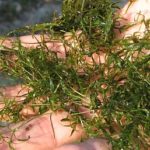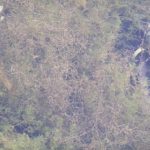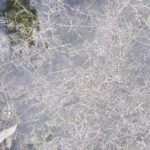Potamogeton pusillus
USDA, NRCS. 2018. The PLANTS Database (http://plants.usda.gov, 28 March 2018). National Plant Data Team, Greensboro, NC 27401-4901 USA.
Illustration courtesy of University of Florida/IFAS Center for Aquatic and Invasive Plants. Used with permission.
What is Baby Pondweed?
Physical Characteristics
Leaves:
- All submersed
- Linear
- Light green
- 2.75 inches & 0.13 inches wide
Flowers:
- Round fan-shaped with slender claw
- 0.05 – 0.08 inches long
Fruits:
- Oval-shaped
- 0.08 – 0.11 inches long
- 0.05 – 0.08 inches wide
- Top is very low and wide
Stems:
- Many branches
- Slender
- Slightly compressed
- Branches often killed by winter-buds
Where Does it Grow?
Baby pondweed can be found in neutral or slightly alkaline or brackish water of ponds and rivers. They often form large masses.
Pros and Cons of Baby Pondweed
Baby pondweed is an excellent food for waterfowl, which eat both the fruits and the tubers. Submerged portions of all aquatic plants provide habitats for many micro and macro invertebrates. These invertebrates in turn are used as food by fish and other wildlife species (e.g. amphibians, reptiles, ducks, etc.). After aquatic plants die, their decomposition by bacteria and fungi provides food (called “detritus”) for many aquatic invertebrates.









